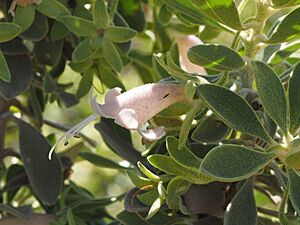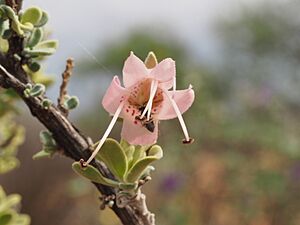Wilcox bush facts for kids
Quick facts for kids Wilcox bush |
|
|---|---|
 |
|
| Eremophila forrestii growing north of the Billabong Roadhouse | |
| Scientific classification | |
| Genus: |
Eremophila (plant)
|
| Species: |
forrestii
|
| Synonyms | |
|
Synonyms
Bondtia forrestii Kuntze orth. var.
Bondtia leucophylla Kuntze orth. var. Bondtia turtonii Kuntze orth. var. Bontia forrestii (F.Muell.) Kuntze Bontia leucophylla (Benth.) Kuntze Bontia turtonii (F.Muell.) Kuntze Eremophila leucophylla Benth. Eremophila sp. 2 aff. leucophylla Eremophila turtoni F.Muell. orth. var. Eremophila turtonii F.Muell. Eremophila xanthotricha Diels Pholidia forrestii (F.Muell.) Wettst. Pholidia leucophylla (Benth.) Wettst. |
|
The Wilcox bush, also known as Eremophila forrestii, is a special flowering plant. It belongs to the figwort family, called Scrophulariaceae. This plant is found only in Australia, which means it is endemic there.
The Wilcox bush is a shrub with many branches. Its branches, leaves, and sepals (the small leaf-like parts that protect the flower bud) are covered in a thick layer of grey or yellow hairs. This makes the plant look and feel like felt. Its flowers are usually cream or pink, with dark red spots or streaks inside. You can find this plant mostly in Western Australia, but also in the far western parts of South Australia and the Northern Territory. There are six different types, or subspecies, of Wilcox bush that scientists recognize.
Contents
What Does the Wilcox Bush Look Like?
The Wilcox bush is a shrub that grows upright and has many branches. It can reach a height of about 0.5 and 2.0 m (2 and 7 ft). Its branches and leaves are covered with a thick, dense layer of grey or bright lemon-yellow hairs. These hairs are branched, making the plant feel soft and fuzzy like felt.
The leaves of the Wilcox bush can be different shapes, depending on the specific type of plant. They can be long and narrow (lance-shaped) or almost perfectly round. Most leaves are about 11–30 mm (0.4–1 in) long and 6–16 mm (0.2–0.6 in) wide.
Flowers of the Wilcox Bush
The flowers usually grow one by one where a leaf meets the stem. Each flower has a stalk that is about 4–24 mm (0.2–0.9 in) long and covered in the same fuzzy hairs as the leaves. There are 5 sepals, which are like small leaves protecting the flower. They are lance-shaped or egg-shaped, fuzzy, and about 9–19 mm (0.4–0.7 in) long.
The petals of the flower are mostly 18–25 mm (0.7–1 in) long. They join together at the bottom to form a tube shape. This petal tube is cream to pink in color. Inside the tube and on the upper parts of the petals, you'll see dark red spots or streaks. Both the inside and outside of the tube are covered with tiny glandular hairs, which can feel sticky. The hairs inside the tube are long. The flower has 4 stamens (the parts that produce pollen) that stick out beyond the end of the petal tube.
The Wilcox bush flowers from April to October. After flowering, it produces fruits. These fruits are dry, oval-shaped to almost round, and about 6.5–9 mm (0.3–0.4 in) long. They have a thin, papery covering.
How the Wilcox Bush Got Its Name
The Wilcox bush was first officially described in 1869 by a scientist named Ferdinand von Mueller. He published his description in a book called Fragmenta phytographiae Australiae. The plant's specific name, forrestii, was chosen to honor John Forrest. He was a famous Australian explorer, politician, and plant collector.
Different Types of Wilcox Bush
As of April 2020, there are five different types, or subspecies, of Eremophila forrestii recognized by plant experts. These are:
- Eremophila forrestii subsp. capensis: This type is also called Cape Range poverty bush. Its leaves and branches are covered in so many grey or yellow hairs that you can't see the green surface underneath. Its leaves are thick and wide, almost round.
- Eremophila forrestii subsp. forrestii: This type also has very hairy leaves and branches, hiding the green color. Its leaves are not thick, and its sepals are lance-shaped (narrow and pointed).
- Eremophila forrestii subsp. hastieana: Like the others, its leaves and branches are densely covered with grey or yellow hairs. Its leaves are not thick, but its sepals are egg-shaped.
- Eremophila forrestii subsp. inland: This type is similar to subspecies forrestii. However, its new leaves are yellow, and its flowers are pale white to pink with clear blotches inside.
- Eremophila forrestii subsp. viridis: This type has fewer hairs on its leaves and branches. The hairs are scattered and can be glandular or branched.
Where the Wilcox Bush Grows
The Eremophila forrestii subspecies forrestii is very common and can be found in many places. It grows from the west coast of Western Australia all the way to the far southwest of the Northern Territory and the far northeast of South Australia. It grows between the latitudes of 21°S and 30°S. In Western Australia, it lives in the Eremaean and South West botanical regions. You can find it in many different places, but it's most common between sand dunes and on flat, sandy areas.
Subspecies capensis only grows in the Cape Range National Park. This area is known for its rocky limestone. Subspecies hastieana is common between Leonora and Nanutarra, and areas to the east. It usually grows in mulga woodland, often on red-brown clay or stony flats. Subspecies viridis is not as well-known and is found near Onslow, Neale Junction, and Well 38 on the Canning Stock Route.
The "inland" subspecies is also common and widespread. It grows from east of Warburton to Tom Price. You can find it in sand dunes and sandplains in these regions.
Protecting the Wilcox Bush
The Western Australian Government Department of Parks and Wildlife keeps track of how many plants are left. Subspecies forrestii, hastieana, and "inland" are considered "not threatened." This means there are plenty of them, and they are not in danger of disappearing.
However, subspecies capensis and viridis are classified as "Priority Three." This means scientists don't know much about them, and they are only found in a few places. While they are not in immediate danger, they are being watched closely to make sure they stay safe.
How People Use the Wilcox Bush
Wilcox Bush in Farming
Sometimes, the Wilcox bush can be used as forage (food) for sheep. However, it's not good for cattle. Farmers can sometimes tell how good their pasture (grassland for animals) is by whether the Wilcox bush is growing there or not.
Wilcox Bush in Gardens
Even though the Wilcox bush is very common in Western Australia, it's not often grown in gardens. However, it has been grown in Victoria and South Australia. It can be tricky to grow new plants from seeds or cuttings. It's easiest to grow it by grafting it onto a Myoporum rootstock (another plant's root system). The Wilcox bush grows best in soil that drains water well, and it likes either sunny or partly shaded spots. Most types of Wilcox bush can handle dry weather and frost.
Images for kids







